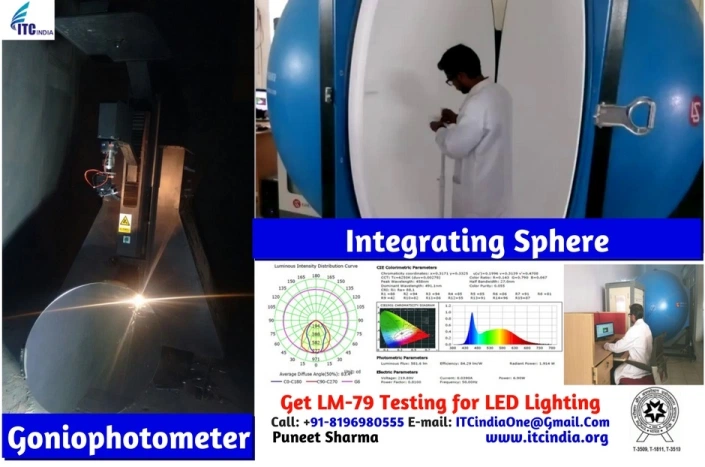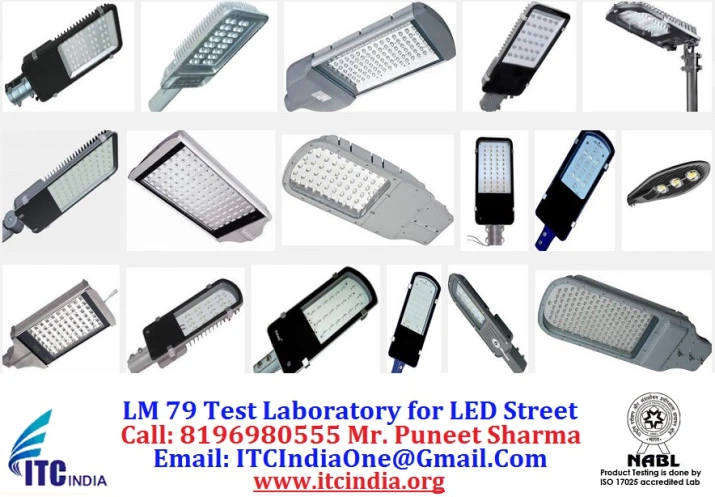Understanding LED tests IES LM-79
What are the limitations of LM-79?
What are the limitations of LM-79?
As we all know about the strength of LM 79. Everything has its pros and cons. Let us have a look on the drawbacks of LM 79.
- LM 79 depicts the parameters of the individual products. So the obtained Parameters cannot be used to access alike products.
- Other limitation is the sample size. It does not state any sample size. So, the manufacturer provides only one sample instead of supplying more. This thus increases the vulnerability of lesser quality products.
- This can be used only to determine complete luminary instead of LED used ( as based on absolute photometry) , which can produce different results due to quality of accessories used like glass, thermal effect, lenses etc.
If you’re Buyers Demanding for LM-79 Testing– Contact Now!
Wish this blog post will be help. If you have any other questions, please feel free to contact us. ITCIndia team looking forward work with you and get better together!
Mr. Puneet Sharma | Call: 08196980555 | E-mail: [email protected]
Get Instant Quotations, Fill the Enquiry form:
This entry was posted in LED Bulb Testing, LED Driver Testing, LED Street Light Testing, LED Testing, LED Tube Light Safety Testing, LM 79 Tesing For Street Light As Per IEC 60598-2-3, LM 79 Testing, LM 79 Testing for LED Floodlights and Streetlights, LM 79 Testing in Kolkata West Bengal India, LM 79 Testing Mumbai Maharashtra India, LM-79 Testing Ahmedabad, LM-79 Testing for LED Batten, Lm-79 Testing for LED COB Down light, Lm-79 Testing for LED COB Spot Lights, Lm-79 Testing for LED COB Zoom light, LM-79 Testing for LED DownLight, LM-79 Testing for LED Flood lights, LM-79 Testing for LED Solar Street Light, Lm-79 Testing for Tube Light, LM-79 Testing in Bangalore Karnataka India, Lm-79 testing lab in India, LM-79 Testing on High bay LED lights, LM-79 testing on High Power LED Light Model, LM-79 Testing | LM-79 Test Approved Methods, Photometric Testing, Photometric Training and tagged & TM21, and TM-21, Calculating SSL Performance from LM-79 -ITCIndia, ISTM, istmt, LED Lighting Facts, led lumen maintenance, led testing labs in india, Lm 79, lm 79 80 standards, lm 79 certificate, lm 79 test, lm 79 testing labs in bangalore, lm 79 testing labs in india, lm 79 testing labs in mumbai, lm 80 report, lm-79 and lm-80 report, LM-79 Luminaire Testing Laboratory, lm-79 requirements, lm-79 test procedure, LM-79 Test Report, LM-79 test reports and luminaire LED quality and performance, LM-79 testing, LM-79 Testing - ITCINDIA, Lm-79 testing Ahmedabad, Lm-79 testing Chennai, Lm-79 testing Delhi, Lm-79 testing India, lm-79 testing kolkata, lm-79 testing lab, Lm-79 testing lab in India, Lm-79 testing Mumbai, lm-80, lm79, lm79 and lm80 standards, lm79 and lm80 testing, lm79 report, lm80 certification, lm80 test procedure, luminaire testing, luminaire testing lab, luminaire testing laboratory, Luminaries/LED Product Testing, sample lm79 report, Searches related to What are the limitations of LM-79, tm 21, Understanding IES LM-79 & IES LM-80, Understanding LED tests IES LM-79, What are the limitations of LM-79?, What are the limitations of LM-79? « Electrical Safety Testing.
What are LM 79 Test Outcomes?
What are LM 79 Test Outcomes?
LM-79 is approved test method for electrical and photometric measurements of Solid State Lighting Products. It describes the procedure in measuring total luminous flux, electrical power, luminous intensity distribution, chromaticity under standard conditions. It covers LED based SSL products with control electronics and heat sink incorporated with AC or DC power supply. This does not include LED chips, LED package or LED module but luminaries (fixtures incorporating light source) as well as integrated LED lamps.
The equipment used in LM-79 is integrated sphere and goniophotometer.
Integrating Sphere Goniophotometer
The test report shall list all significant data for each SSL product tested together with performance data. The outcomes of the LM-79 test are:
- Correction factor applied ( e.g. spectral mismatch, self absorption , intensity distribution etc.)
- Measured total luminous flux( lumen(lm)), input voltage(v), current(a), power(w), Luminous intensity distribution(cd), efficacy(lm/w)
- Color quantities( chromaticity coordinates, CCT, CRI )
- Spectral power distribution
- Bandwidth of spectoradiometer, if spectral distribution and/or color quantities are reported.
- Statement of uncertainties (if required)
- Deviation from standard operating procedures, if any.
Here is the link of a test report issued by our prestigious company. LM 79 Test Outcomes
If you’re Buyers Demanding for LM-79 Testing– Contact Now!
Wish this blog post will be help. If you have any other questions, please feel free to contact us. ITCIndia team looking forward work with you and get better together!
Mr. Puneet Sharma | Call: 08196980555 | E-mail: [email protected]
Get Instant Quotations, Fill the Enquiry form:
This entry was posted in LED Testing, LM 79 Testing and tagged and TM-21, Best LM 79 Testing Lab, CCT and power factor . Contact us Now, Chromaticity coordinates, CRI, Electrical Properties, Get Lm 79 Test Report in 5 days, ies lm-80, Input AC power, Input RMS AC current, Input RMS AC voltage, Input voltage frequency, Instrument solutions for lm-79, Lamps & Luminaires - EMC-EMI Testing lab in Delhi, Lamps & Luminaries |LED Testing lab in Delhi, led light testing laboratory in india, LED Lighting Facts® LED Lumen Maintenance and Warranty Labele, led testing lab in india, LID, list of nabl accredited labs, list of nabl accredited labs for LED testing, list of nabl accredited labs for Lm testing, List of NABL Labs in India, Lm 79, lm 79 80 standards, LM 79 testing by NABL - Accredited lab in just 5 days, lm 79 testing labs in india, lm 79 testing labs in maharashtra, lm 80 report, lm 80 standard pdf, LM-79 LM-80 Technical Report, LM-79 Test Report, LM-79 test reports and luminaire LED quality and performance, LM-79 Testing Laboratory, lm-79 Testing | lm 79 test report - Electrical Safety Testing Lab ITC India, lm-80, lm79 and lm80 standards, LM79-08 Approved Method, Lumens, luminaries testing lab, Luminous efficacy (lumens/W), Luminous flux (lumens), Luminous intensity distribution (candelas), nabl accredited labs for LED testing, nabl approved lab list, NABL Lab for lm 79 testing, National Accreditation Board for Testing and Calibration Laboratories, Photometric lab, Photometric Properties, photometric testing labs, Photometric Testing: Lamp - LED - Luminaire Testing, sample lm79 report, Searches related to What are LM 79 Test Outcomes, SPECIFIC CRITERIA for PHOTOMETRY TESTING LABORATORIES, Testing efficient luminaires and LED retrofit lamps, tm 21, tm-21 led, Top lm 79 testing lab in Ahmedabad, Top lm 79 testing lab in bangalore, Top lm 79 testing lab in india, Top lm 79 testing lab in Mumbai, Top lm 79 testing lab in New Delhi, Top lm 79 testing lab in pune, Understanding LED tests IES LM-79, What are LM 79 Test Outcomes?.
LM 79 Test Laboratory for LED Street Light
LM-79 Testing for LED Street Lights
ITC India NABL Accredited Electrical Safety Testing Laboratory provide LM-79 Testing for LED Street Light (45W & 60W) includes accreditation for Solid State Lighting Luminaires, Total Flux Measurements (Luminous Efficacy) & Solid State Lighting Luminaires, Luminous Intensity Measurements.
The Testing to be conducted is as follows(Testing as per standard):-
Test to be conducted under LM 79:
- Measurement of Total Luminous Flux & Luminous Efficacy
- Color Characteristics (Chromaticity Coordinates, Correlated Color Temperature & Color Rendering Index)
- Light Intensity Distribution Test
IES LM-79-08 Testing Parameters, LM-79 Testing Approved Method: Electrical and photometric Measurements of Solid-state Lighting Product
LM-79 Test Photometric Results:
Colorimetric Parameters:
- Chromaticity coordinates: (Chroma x / Chroma y / Chroma u(u’) / Chroma v / Chroma v’)
- Correlated Color Temperature (CCT)
- Duv Value
- Color Ratio
- Peak Wavelength (nm)
- Half Bandwidth (nm)
- Dominant Wavelength (nm)
- Color Purity
- Color Rendering Index (CRI – Ra)
Photometric Parameters:
- Total Luminous Flux (Lumens)
- Luminous Efficacy (Lumens/Watt)
- Radiant Power (Watts)
Electrical Results:
- Input Power (Watts)
- Input Voltage (Volts )
- Input Current (Amps)
- Power Factor
- Input Frequency (Hz)
Additional Parameters:
- Stabilization Time (Light and Power) = 60 minutes
- Test Geometry Configuration = 4π
- Spectroradiometer = (Lisun LMS-9000A Plus)
- Ambient Temperature = 25.0°C
Click Here to See Video How to Do LM-79 Testing ?
If you have any Query for LED Luminaires Testing, You can Feel free to Contact Us
If you are Interested You can Fill out the form below to receive a quote on the LM-79 Testing to get started:
Contact Now!
Puneet Sharma, M: 08196980555 E: [email protected]
This entry was posted in LM 79 Tesing For Street Light As Per IEC 60598-2-3, LM 79 Testing, LM-79 Testing Ahmedabad, LM-79 Testing on High bay LED lights, LM-79 testing on High Power LED Light Model, LM-79 Testing | LM-79 Test Approved Methods and tagged 30W Led Street Light LM79 Test Report in 2 days, Call for Lm-79 Testing 08196980555, Email for LM-79 Testing [email protected], Jammu (winter), Lamps & Luminaires - LM-79 Testing lab in Delhi, LED Lighting Facts Approved Labs India, LED Luminaire Testing to Include LM-79 in Ahmedabad, LM 79 Test Laboratory - LED/SSL Luminaires India, LM 79 Test Laboratory for LED Street Light, LM 79 Testing at ITCindia, Lm 79 testing service provider in India, LM-79 Luminaire Testing Agartala, LM-79 Luminaire Testing Aizawl, LM-79 Luminaire Testing Andaman and Nicobar Islands, LM-79 Luminaire Testing Andhra Pradesh, LM-79 Luminaire Testing Arunachal Pradesh, LM-79 Luminaire Testing Assam, LM-79 Luminaire Testing Bengaluru, LM-79 Luminaire Testing Bhopal, LM-79 Luminaire Testing Bhubaneswar, LM-79 Luminaire Testing Bihar, LM-79 Luminaire Testing Chandigarh, LM-79 Luminaire Testing Chennai, LM-79 Luminaire Testing Chhattisgarh, LM-79 Luminaire Testing Dadar and Nagar Haveli, LM-79 Luminaire Testing Daman, LM-79 Luminaire Testing Daman and Diu, LM-79 Luminaire Testing Dehradun, LM-79 Luminaire Testing Delhi, LM-79 Luminaire Testing Dispur, LM-79 Luminaire Testing Gandhinagar, LM-79 Luminaire Testing Gangtok, LM-79 Luminaire Testing Goa, LM-79 Luminaire Testing Gujarat, LM-79 Luminaire Testing Haryana, LM-79 Luminaire Testing Himachal Pradesh, LM-79 Luminaire Testing Hyderabad, LM-79 Luminaire Testing Imphal, LM-79 Luminaire Testing In Mumbai, LM-79 Luminaire Testing India, LM-79 Luminaire Testing Itanagar, LM-79 Luminaire Testing Jaipur, LM-79 Luminaire Testing Jammu and Kashmir, LM-79 Luminaire Testing Jharkhand, LM-79 Luminaire Testing Karnataka, LM-79 Luminaire Testing Kavaratti, LM-79 Luminaire Testing Kerala, LM-79 Luminaire Testing Kohima, LM-79 Luminaire Testing Kolkata, LM-79 Luminaire Testing Lakshadweep, LM-79 Luminaire Testing Lucknow, LM-79 Luminaire Testing Madhya Pradesh, LM-79 Luminaire Testing Maharashtra, LM-79 Luminaire Testing Manipur, LM-79 Luminaire Testing Meghalaya, LM-79 Luminaire Testing Mizoram, LM-79 Luminaire Testing Mumbai, LM-79 Luminaire Testing Nagaland, LM-79 Luminaire Testing Odisha, LM-79 Luminaire Testing Panaji, LM-79 Luminaire Testing Patna, LM-79 Luminaire Testing Pondicherry, LM-79 Luminaire Testing Port Blair, LM-79 Luminaire Testing Puducherry, LM-79 Luminaire Testing Punjab, LM-79 Luminaire Testing Raipur, LM-79 Luminaire Testing Rajasthan, LM-79 Luminaire Testing Ranchi, LM-79 Luminaire Testing Shillong, LM-79 Luminaire Testing Shimla, LM-79 Luminaire Testing Sikkim, LM-79 Luminaire Testing Silvassa, LM-79 Luminaire Testing Srinagar (summer), LM-79 Luminaire Testing Tamil Nadu, LM-79 Luminaire Testing Telangana, LM-79 Luminaire Testing Thiruvananthapuram, LM-79 Luminaire Testing Tripura, LM-79 Luminaire Testing Uttar Pradesh, LM-79 Luminaire Testing Uttarakhand, LM-79 Luminaire Testing West Bengal, lm-79 test procedure India, LM-79 Testing for LED Street Light, LM-79 Testing for LED Street Light (45W & 60W), LM-79-08 Test Report for LED Lighting, LM-79-08 Test Report for LED Street Light, Solutions for LM-79 In Chennai, Understanding LED tests IES LM-79.


